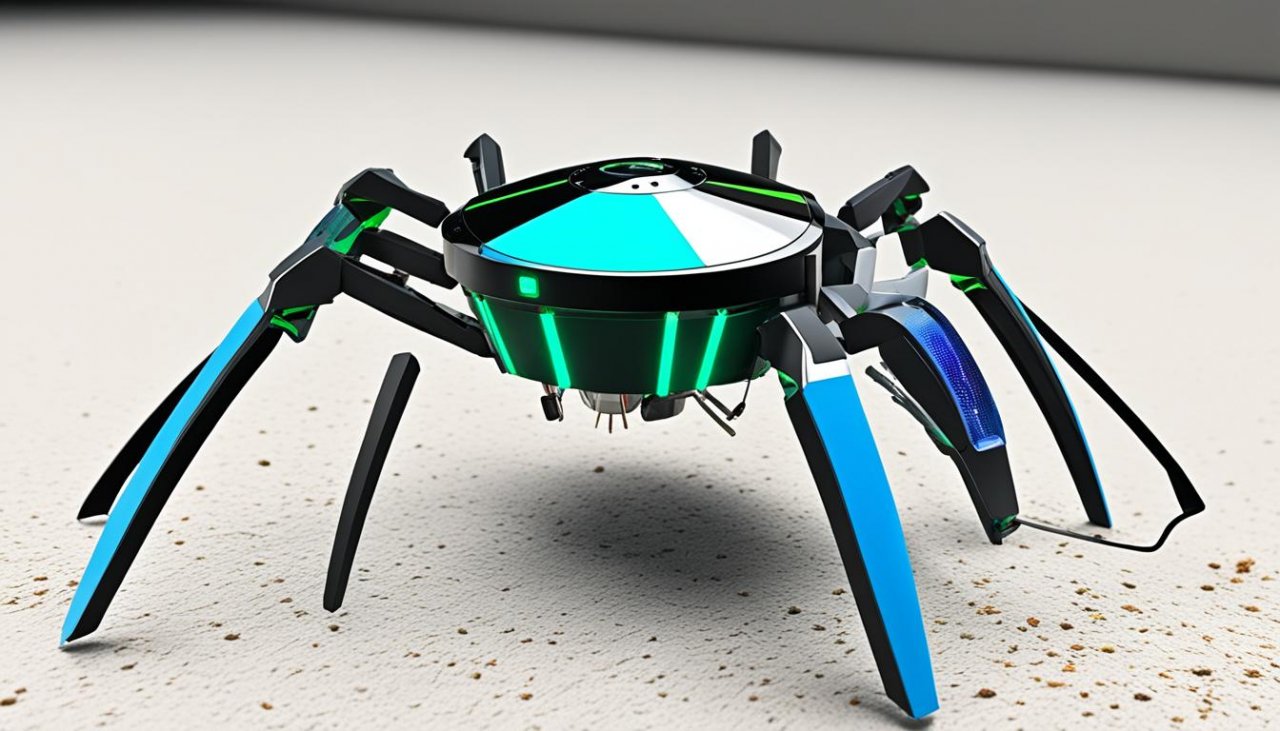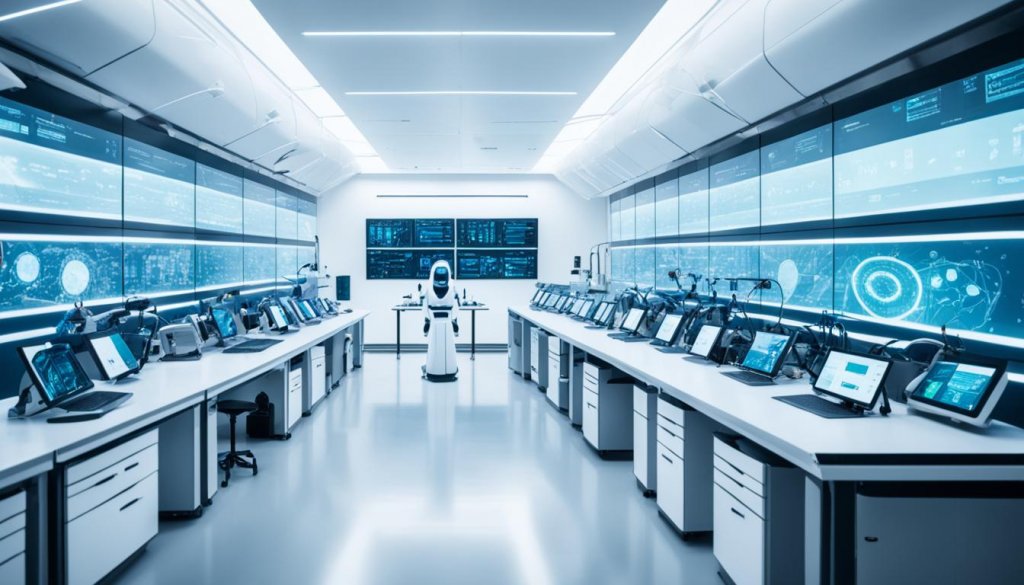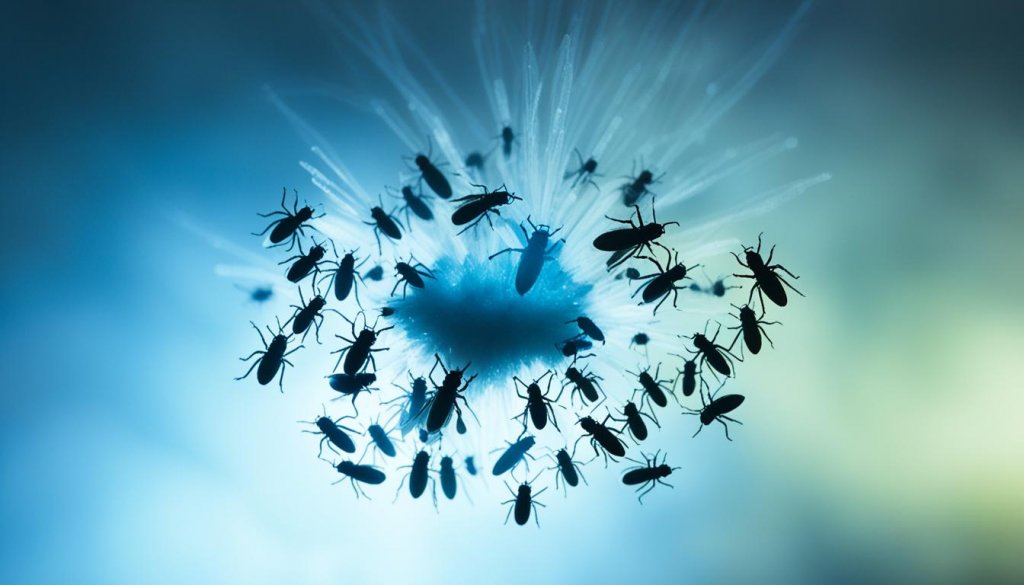As I sat on my porch, enjoying a quiet evening, I noticed mosquitoes buzzing around. They were ruining my peace. I thought about how climate change is making pest infestations worse in cities. These pests are more than just annoying; they show a big problem with our environment and the tech we’re using to fight them.
In 2024, pest control will change a lot with new tech. We’ll see smart traps with sensors and drones checking for pests in tough spots. This new era in pest control will mix tech with green solutions. Let’s look at what’s coming this year.

Key Takeaways
- 2024 sees a spike in urban pest infestations due to climate change.
- Smart traps are reducing the need for frequent inspections.
- Drones are enhancing pest detection in hard-to-reach areas.
- Companies are increasingly adopting eco-friendly pest control methods.
- There’s a focus on Integrated Pest Management (IPM) for sustained pest control solutions.
- Technology is streamlining pest monitoring and management for homeowners.
Introduction to Pest Control Technology Innovations
I’m really into the latest in Pest Control Technology. Pests bring big challenges that need smart, green solutions. Old ways often use harsh chemicals, which can make pests stronger and harm good insects and animals. Now, new solutions are coming up to fix these problems and help pros in pest control.
Advanced detection systems are a big deal now. They use sensors and data to spot pests fast. These systems check things like temperature, humidity, and sounds. This means we can catch infestations early and manage them better.
Integrated Pest Management (IPM) is another big step forward. It combines different ways to control pests, like using fewer chemicals. This approach helps create environments where pests don’t easily survive. It’s all about being smart and careful in how we control pests.
IoT-based solutions are changing the game in pest control too. They help spot pests early and cut down on the need for constant checks and treatments. This saves money and protects our properties and crops. Robots and drones are also playing a big role. They can fly over fields and find pests on their own, without hurting good bugs.
These new technologies let pros in pest control do their job better and think about the planet. As we look into these innovations, it’s clear they’re leading us to a smarter, greener way to fight pests.
Emerging Trends in Pest Control Services
As I explore the changing world of pest control, I see big trends towards eco-friendly solutions. Most homeowners, 92%, want sustainable options, pushing the industry to innovate. Companies are now using green practices, which appeals to those who care about the planet. This shift helps us live in better harmony with nature.
Rise of Eco-Friendly Solutions
Eco-Friendly Pest Control is more than a trend; it’s a big change in how we handle pests. Many clients, 62%, are making their homes more sustainable. Integrated Pest Management (IPM) is key in this change. It uses gentle methods to control pests and protect the environment.
Using natural predators and microbes shows a dedication to being kind to our planet.
Integration of Technology for Efficiency
Technology is changing pest control for the better. New systems make things like reporting and monitoring easier, which means better service and faster results. This tech helps make things more convenient for customers, which is what 83% of consumers now look for.
AI, smart systems, and apps are helping experts give quick, custom, and effective help.
The Role of Integrated Pest Management (IPM)
Integrated Pest Management (IPM) is key in fighting pests today. It uses different methods to create a plan for managing pests in a sustainable way. Learning about IPM helps us find effective and green ways to deal with pests.
Understanding IPM Strategies
IPM is a complete approach that combines biology, culture, physical, and chemical methods. It aims to protect health, the environment, and the economy. By identifying and monitoring pests, we can act only when needed, making our efforts more precise.
Benefits of IPM in Pest Control
IPM does more than just reduce pests. Studies show that farms using IPM have less pest damage than those using old methods. In cities, IPM has cut down pesticide use, making people healthier and safer. It’s a win-win for fighting pests now and keeping our planet and economy strong for the future.
Advancements in AI and Machine Learning
AI is changing pest control, making it more efficient and precise. It uses advanced machine learning to identify pests with over 95% accuracy. This leads to better pest management strategies and less chemical use, which is good for the planet.
AI for Accurate Pest Identification
AI helps identify pests accurately, making pest control more effective. It analyzes data to predict pest behavior, increasing accuracy by 60%. This means pest control can act fast and target problems before they get worse.
AI helps fight agricultural pests, reducing losses in global agricultural production by 20% to 40% each year.
Cost Reduction through Automation
Automation cuts costs in pest control services. AI technology uses smart sensors to detect pests 70% faster than old methods. This reduces pesticide use by 50% in farms and makes resource use 40% more efficient.
This leads to big savings for pest control companies and quick responses to pest problems, helping customers.

Utilization of IoT Smart Traps
IoT technology has changed how we monitor pests with Smart Traps. These tools are a big deal because they collect data in real-time. This makes managing pests more efficient. Experts say we’ll see 1.7 million monitoring devices by 2025, showing the trend is growing.
Smart Traps cut down on the need for manual checks. They automatically detect and track pests. This means I can target treatments better, not just spray everything. It makes pest control more effective and less harmful to the environment by using fewer chemicals.
IoT technology also brings us devices like Smart Electronic Pest Repellers and Smart Insect Lights. These work with Smart Traps to manage pests well. IoT-connected traps send data fast, helping us act quickly against pests. This keeps crops safe and cuts down on losses.
Looking ahead, Smart Traps and IoT tech will keep getting better. They’ll help with pest control in homes and businesses. As these devices get cheaper, more people will use them. This leads to smarter and greener ways to manage pests.
Drones: A Safe Solution for Pest Inspections
Drones have changed the game in pest control, especially for inspections. They make pest management safer and more efficient. With drones, I can check rooftops and hard-to-reach areas safely and quickly.
How Drones Improve Efficiency
Using drones in pest control boosts efficiency a lot. For example, our drones can clear one nest every minute. This is crucial because the browntail moth is getting more common in the Northeast. Traditional methods can harm the environment.
But drones use cameras and sensors to get rid of nests without chemicals. This approach is fast, safe, and good for the environment. It effectively controls infestations while protecting nature.
Minimizing Risk for Technicians
Keeping technicians safe is key in pest control, and drones are a big help. They cut down on accidents and exposure to dangerous pesticides. Drones work with precision, saving on labor costs and making the workplace safer.
Regular checks with drones help spot pest problems early. This means we can act fast and keep people and the environment safe.
Biological Pest Control Methods
Biological pest control methods are great for the environment. They use natural predators and microbial agents. This approach cuts down on synthetic pesticides and helps keep ecosystems balanced.
Use of Natural Predators
Natural predators are becoming more popular in pest control. Creatures like ladybugs and parasitoids help control pests. They reduce the need for harmful chemicals, making our environment safer.
These predators are not only effective but also help increase the variety of life in gardens and farms.
Microbial Agents in Pest Management
Microbial agents, like Bacillus thuringiensis (Bt), are becoming key in fighting pests. This bacterium targets pests without harming people or beneficial insects. As we learn more about the dangers of synthetic pesticides, more people are choosing microbial agents.
This choice helps maintain a healthy balance in controlling pests over time.
Pheromonal Pest Control Techniques
Pheromonal Pest Control is becoming a top choice for managing pests without harming the environment. It uses pheromones in traps to keep an eye on pests in farms and homes. This method catches infestations early, reducing damage to crops and plants.
Each pheromone targets specific insects, so traps won’t work for all pests. This method is safer than traditional pesticides and fits well with green solutions. It’s key to replace the lures often and check traps after storms for any damage.
It’s crucial to place traps in the right spots, away from people and pets. Don’t use outdoor traps inside, and always follow the product instructions. Washing my hands after handling pheromones helps prevent attracting more pests. Companies are embracing pheromonal pest control to lead in eco-friendly pest management.

Precision Targeting with Receptor Interference Strategies
In my search for new ways to fight pests, I found receptor interference to be a game-changer. It stops pests from communicating and reproducing. This makes pest control more precise and safe for good insects and the environment.
Studies show it works well with green innovations. For example, some insects like beetles respond well to this method. This makes them perfect for using receptor interference in pest control.
This approach matches my goal of protecting the environment. Using fewer chemicals helps our surroundings and the planet. As it gets better, receptor interference could change how we manage pests, reducing harm and increasing success.
Engaging Customers with Personalized Pest Control Services
In today’s market, strong customer engagement is crucial for success. Offering personalized pest control services meets client needs and boosts satisfaction and loyalty. When clients can shape their pest management plans, they feel valued and trust their service provider more.
Importance of Customized Plans
Customized pest control plans boost customer engagement. Every home and business has its own challenges. By letting clients customize their pest control, companies can tackle specific issues better. This leads to better results and higher satisfaction.
Personalized Pest Control helps keep clients happy because their needs are met. It also builds long-term relationships, which is cheaper than getting new clients.
Convenient Online Scheduling Options
Technology has made online scheduling key to a great customer experience. Many like to book services when it’s convenient for them, avoiding phone calls and long waits. Online Scheduling makes it easy for clients to find the best time for pest control.
This makes customers happier and helps a company look good. Using modern scheduling helps meet customer needs and makes things easier for the company too.
Pest Control Market Growth and Predictions for 2024
The pest control market is growing fast, with experts expecting it to keep growing. Climate change is making pests more active, which means more people need pest control services. This, along with a desire for eco-friendly options, will keep the industry growing.
Experts predict a 5.2% growth rate from 2018 to 2023. This looks promising for the future, especially with more private equity investing in pest control. In 2023, there was an 18.8% increase in private equity deals, showing strong interest in the field.
Even when the economy is tough, people keep investing in pest control. This is because it’s seen as a stable option. The US is a key player in this market, with big growth expected through 2029.
Understanding the trends in pest control is crucial for those in the industry. The market is changing, and knowing what consumers want is key. I’m excited to see how these trends will shape the industry in 2024 and the years to come.
Conclusion
The future of pest control is changing a lot by 2024. We’ll see more advanced technologies and eco-friendly methods. These changes aim to meet the specific needs of homes and businesses. They also help protect the environment.
Pests can be a big health risk. Mosquitoes and ticks can spread diseases. Termites can damage buildings. That’s why we need experts in pest control. They use special tools and know-how to keep our spaces safe.
Working together, we can make our living areas healthier. The pest control industry is evolving to meet these challenges. We’re moving towards a future where our homes and communities are safe, efficient, and kind to the planet.
See how FieldAx can transform your Field Operations.
Try it today! Book Demo
You are one click away from your customized FieldAx Demo!
FAQ
What are the latest innovations in pest control technology for 2024?
The latest in pest control includes AI and machine learning for better pest identification. IoT smart traps help with monitoring. And, there are eco-friendly methods like Integrated Pest Management (IPM) that focus on sustainable pest removal.
How do eco-friendly pest control solutions work?
These solutions use fewer chemicals and rely on natural predators and microbial agents. They also use pheromonal pest control. This makes pest management more sustainable and meets the demand for greener options.
What is Integrated Pest Management (IPM)?
IPM uses observation, monitoring, and eco-friendly treatments for targeted pest control. It aims to reduce environmental harm while offering effective pest control over time.
How can AI enhance pest control services?
AI helps identify pests accurately through data analysis. This lets exterminators use the right treatments. It also automates tasks, making operations more efficient.
What role do smart traps play in pest management?
Smart traps use IoT tech for real-time monitoring. They automate pest tracking and cut down on manual checks. This leads to better targeted treatments and more effective pest management.
How do drones improve pest inspections?
Drones make inspections safe and quick by reaching hard spots like rooftops. They help professionals check for pests fast and find where they enter without danger.
What are pheromonal pest control techniques?
These techniques use pheromones to stop pests from mating and track infestations. It’s a way to control pests with less chemical use, making it more eco-friendly.
What are receptor interference strategies in pest control?
These strategies block pests’ communication, stopping their reproduction. They have less effect on good insects and the environment. This new tech could change how we manage pests.
Why is customer engagement important for pest control services?
It’s key for offering services that meet customers’ specific needs. Better satisfaction and loyalty come from personalized and easy customer interactions.
What factors are contributing to the growth of the pest control market?
The market is growing because of climate change, more demand for sustainable practices, and new tech. These innovations make pest control services better and more effective.
Author Bio
Co-Founder & CMO at Merfantz Technologies Pvt Ltd | Marketing Manager for FieldAx Field Service Software | Salesforce All-Star Ranger and Community Contributor | Salesforce Content Creation for Knowledge Sharing






